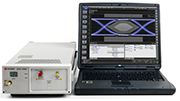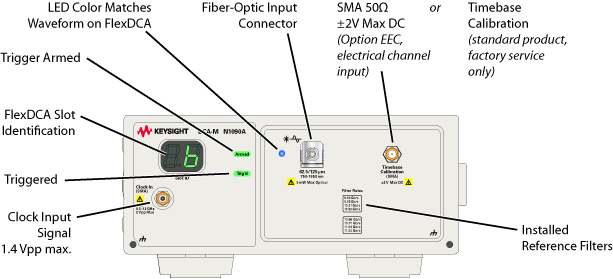N1090A DCA-M Single Optical Channel Oscilloscope

The N1090A DCA-M is a single optical channel sampling oscilloscope module that is controlled via USB from a PC. Option EEC adds a single electrical channel. The N1090A is controlled using the same FlexDCA user interface that is used to control the DCA-X. As a result, DCA-X users will be very familiar with operating the N1090A as well as using remote control. The N1090A DCA-M uses the high-performance elements of both the DCA-X oscilloscope mainframe acquisition system and the optical channel of the 86105C module. The N1090A can be configured to perform optical transmitter compliance tests.
- To use an N109X-series oscilloscope
- N1090A Specifications
Maximum Clock In non-destruct input voltage is 1.4Vpp. The recommended input is <500 mVp-p.
For installation, safety, and regulatory information, refer to the N1090A user's guide which can be downloaded from keysight.com.
N1090A Front Panel

This module requires FlexDCA firmware version A.05.00 or above.
Key Concepts
- Input signal's wavelength must be from 750 nm to 1630 nm (multimode or single-mode).
- Input signal's symbol rate must be the same as a supported Filter Rate listed on the N1090A's front panel. Otherwise, the input signal will be severly filtered.
- Multiple N1090A's can be connected to FlexDCA. Delta time values between two channels cannot be compared because each N1090A (and DCA-X if connected) uses an independent trigger.
- An DCA-X can simultaineously be connected to FlexDCA.
- Simulated waveforms can be displayed on FlexDCA.
- Trigger can be set to Front Panel or Free Run only.
- Clock In should be at the input signal's symbol rate for proper display of the input signal. However, the N1090A will trigger with any clock signal between 500 MHz and 12 GHz.
- Pattern lock is unavailable if the N1090A's channel is turned on. The N1090A is not compatible with pattern lock.
- Use FlexDCA's remote programming commands to configure the N1090A.
N1090A Features
- Increased sampling rate.
- Perform optical transmitter compliance tests at a variety of standard symbol rates from 1.25 to 11.3 GBd.
- Ability to perform eye-mask tests and measure eye diagram parameters including extinction ratio.
- Low-noise, high sensitivity calibrated reference receivers that are compliant to industry standard tolerances. The reference receivers are selected at the time of order and are noted as Filter Rates on the N1090A's front panel.
- Ability to perform basic oscilloscope mode measurements of pulses rather than eye diagrams (limited to patterns less than 2 ns in duration).
Aligning waveforms
Because a DCA-M’s acquisition system is independent of the DCA-X, the input waveforms may not align after an Auto Scale. This happens if your are using multiple DCA-Ms or a DCA-M with DCA-X receiver modules. To align the waveforms:
- Use Rapid Eye to align the channels. If option 500, Productivity Package Software, is installed on the DCA-X or DCA-M, Rapid Eye is available. Turn on Rapid Eye and the waveforms will align during an Auto Scale. Option 500 is the most convenient way to align the waveforms and maintains very fast throughput. Perform these steps:
- Click Setup > Acquisition to open the Acquisition Setup dialog.
- Select Enable Rapid Eye.
- Select Align Channels During Auto Scale.
- Manually delay the channels. If option 500 is not installed, you can manually add software delay to channels. Although this technique works, acquisition throughput will be reduced. For example, if channels 1A, 2A, and 3A are displayed, add software delay to channels 2A and 3A. The delays are referenced to channel 1A because Auto Scale aligns on the lowest numbered channel that is displayed. To add software delay,
- Click Auto Scale to autoscale the lowest numbered channel.
- For the remaining channels:
- Click Setup > Modules > Channels and select the channel.
- In the Setup dialog, click Advanced for the channel.
- Click Software Delay and enter the desired delay.
Rapid Eye is not available when using math functions or pattern lock.
Inability to Pattern Lock
The N1090A does not have the ability to lock on a waveform pattern as is possible with the DCA-X. Therefore, measurement features that require pattern lock will not operate when used with the N1090A system. These include:
- Advanced Jitter Analysis
- Advanced Waveform Analysis
- Advanced Amplitude Analysis/RIN
- InfiniiSim-DCA Waveform Transformation Toolset.
Option IRC
Option IRC provides optical channel System Impulse Response Correction (SIRC) measurement and data files. These files provide an ideal channel response. SIRC data can be applied in the System Impulse Response Correction dialog. The SIRC correction data feature is a digital filter that is used to:
- Improve the response of module reference filters to more closely match an ideal receiver.
- Enable non-standard reference receiver rates or bandwidths.
- Increase the bandwidth of the channel by up to 50%.
- Ensures that an eye diagram will look identical between different modules.
SIRC correction data is unique to a specific module (serial number). Option IRC comes standard with N1030A/B, N1032A/B, and N1040A plug-in modules and does not need to be purchased. You can purchase Option IRC ships for the N1092-series DCA-M modules.
| Module/Option | Channel | Range1, 2 Min SIRC Freq. |
Range1, 2 Max SIRC Freq. |
|---|---|---|---|
| N1090A Option 140 or 160 | All | 50% of filter rate | 150% of filter rate |
| N1090A Option 200, or 204 | All | 4.97 GBd (3.73 GHz) | 16.06 GBd (12.05 GHz) |
Optical NRZ signals typically require a 4 pole Bessel filter at 75% of the data rate; Optical PAM 4 signals typically require a 4 pole Bessel filter at 50% of the data rate.
Only available with option IRC and compliance not guaranteed.
N1090A Front-Panel Indicator Lights
| Indicator | Description |
|---|---|

|
Displays the FlexDCA extended module slot where the N1090A is installed. The number indicates the channel, which in this picture would be channel 6A. |

|
Green Trigger light indicates that the N1090A is being triggered. As with the DCA-X, this does not indicate that the trigger signal is synchronous with the channel input signal. The trigger must be set to Front Panel and not Module. |

|
Red Trigger light indicates that the clock input signal is missing. |

|
Trigger light off indicates that the N1090A channel is turned off or if FlexDCA is in single/stop acquisition mode. |

|
Trigger armed light. This light is red if FlexDCA is in single/stop acquisition mode. |

|
Channel indicator light. This light is next to the fiber-optic input connector. When on, the light indicates that the associated FlexDCA channel is turned on and that the waveform is displayed. The light is the same color as the displayed waveform. The Trig'd and Armed indicators do not light unless the channel is turned on. |
Remote programs previously developed using the DCA-X FlexDCA interface can be leveraged directly to control an automated N1090A system. Use FlexDCA SCPI programming tools to simplify conversion of legacy 86100-based automation to FlexDCA compatible code. Measurement results are generally 50% faster with the new N1090A due to a significantly faster sampling rate.
To avoid damaging the N1090A's front-panel fiber-optic connector, use proper connection techniques.
Front-Panel Fiber-Optic Input
Click here to learn about fiber-optic connector care. Use caution as fiber-optic end surfaces are easily damaged due to improper cleaning techniques and repairs can be expensive.
The N1090A's front-panel fiber-optic input adapter can be removed and cleaned as shown in the following picture. To remove the fiber-optic adapter:
- Lift the receptacle latch as shown in the following picture.
- Carefully pull off the receptacle without touching the ferrule or fiber end.

Calibrations
The following calibrations are available for the N1090A within FlexDCA. Each is run from within FlexDCA's Calibration dialog.
- Vertical Calibration
- Allows you to calibrate the N1090A input channel's vertical response. This calibration is performed without an input signal.
- This calibration is located in the N1090A tab on the Calibrations dialog.
- Dark Level Calibration
- Improves the accuracy of extinction ratio measurements by identifying internally generated offset (dark level) signals generated by external optical-to-electrical converters and removing them from the measurement. This calibration is performed without an input signal.
- This calibration is located in the Dark Level tab on the Calibrations dialog.
- User Optical Calibration
- A user calibration of the optical channel at any wavelength between 750 nm to 1650 nm. An external CW optical source is required.
- This calibration is located in the Optical tab on the Calibrations dialog.
- Factory Optical Calibration
- A factory calibration of the optical channel is performed at 850 nm, 1310 nm and 1550 nm. An external CW optical source is required.
- This calibration is located in the Optical tab on the Calibrations dialog.
- Timebase Calibration
- The N1090A has its own timebase. If multiple N1090As are used or additional timebases are present, calibrations for each timebase will be listed in the Calibrations dialog. The calibration for each N1090A is clearly labeled by input channel. Other timebases include any N1000A-PTB, 86107A module, N1060A-PTB, or 86108B-PTD modules.
- This calibration is located in the Timebase tab on the Calibrations dialog
Options
In the following table, one and only one of the reference receiver options must be selected at the time that the N1090A is ordered. Options cannot be combined. However, if your test needs change, the N1090A can be returned to a Keysight service center to convert from any of the existing installed reference receiver option to another option. An unfiltered mode is not available in any option.
| Model/option number | Description | |
|---|---|---|
| N1090A-140 | Reference receiver filters for 1.244/1.25/1.229 Gb/s | |
| N1090A-160 | Reference receiver filters for 2.458/2.488/2.5 Gb/s | |
| N1090A-200 | Reference receiver filters for 8.5/9.95/10.3/10.5/10.66/10.71/11.1/11.3 Gb/s | |
| N1090A-204 | Reference receiver filters for 8.5/9.95/10.3/10.5 Gb/s | |
| N1090A-EEC | Enable electrical channel | |
| N1090A-PLK | Pattern lock trigger hardware | |
| N1090A-IRC | Impulse response correction1 | |
| N1090A-C0C | Certificate of Calibration | |
| N1090A-UK6 | Commercial calibration certificate with test data | |
| N1090A-1CM | Single instrument rack mount kit | |
| N1090A-1CN | Dual instrument side-by-side rack mount kit |
Requires option PLK.
Available Package Licenses
| Option | Description |
|---|---|
| RND | Research and Development Package license |
| MFG | Manufacturing Package license |